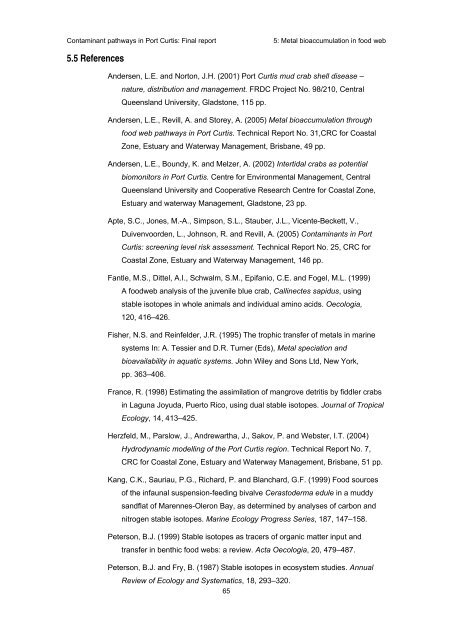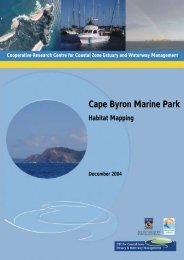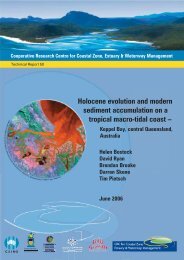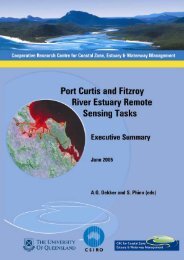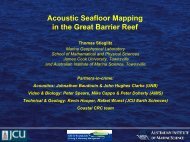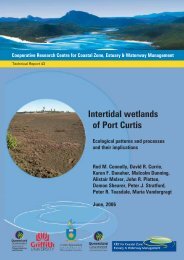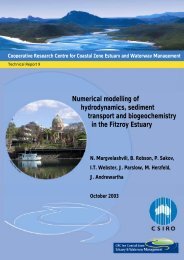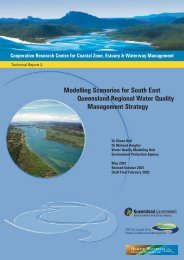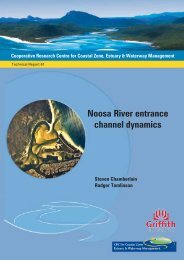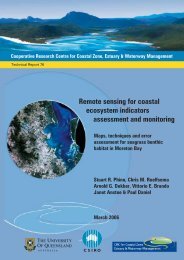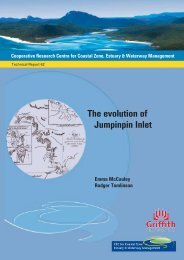Contaminant pathways in Port Curtis: Final report - OzCoasts
Contaminant pathways in Port Curtis: Final report - OzCoasts
Contaminant pathways in Port Curtis: Final report - OzCoasts
You also want an ePaper? Increase the reach of your titles
YUMPU automatically turns print PDFs into web optimized ePapers that Google loves.
<strong>Contam<strong>in</strong>ant</strong> <strong>pathways</strong> <strong>in</strong> <strong>Port</strong> <strong>Curtis</strong>: F<strong>in</strong>al <strong>report</strong>5: Metal bioaccumulation <strong>in</strong> food web5.5 ReferencesAndersen, L.E. and Norton, J.H. (2001) <strong>Port</strong> <strong>Curtis</strong> mud crab shell disease –nature, distribution and management. FRDC Project No. 98/210, CentralQueensland University, Gladstone, 115 pp.Andersen, L.E., Revill, A. and Storey, A. (2005) Metal bioaccumulation throughfood web <strong>pathways</strong> <strong>in</strong> <strong>Port</strong> <strong>Curtis</strong>. Technical Report No. 31,CRC for CoastalZone, Estuary and Waterway Management, Brisbane, 49 pp.Andersen, L.E., Boundy, K. and Melzer, A. (2002) Intertidal crabs as potentialbiomonitors <strong>in</strong> <strong>Port</strong> <strong>Curtis</strong>. Centre for Environmental Management, CentralQueensland University and Cooperative Research Centre for Coastal Zone,Estuary and waterway Management, Gladstone, 23 pp.Apte, S.C., Jones, M.-A., Simpson, S.L., Stauber, J.L., Vicente-Beckett, V.,Duivenvoorden, L., Johnson, R. and Revill, A. (2005) <strong>Contam<strong>in</strong>ant</strong>s <strong>in</strong> <strong>Port</strong><strong>Curtis</strong>: screen<strong>in</strong>g level risk assessment. Technical Report No. 25, CRC forCoastal Zone, Estuary and Waterway Management, 146 pp.Fantle, M.S., Dittel, A.I., Schwalm, S.M., Epifanio, C.E. and Fogel, M.L. (1999)A foodweb analysis of the juvenile blue crab, Call<strong>in</strong>ectes sapidus, us<strong>in</strong>gstable isotopes <strong>in</strong> whole animals and <strong>in</strong>dividual am<strong>in</strong>o acids. Oecologia,120, 416–426.Fisher, N.S. and Re<strong>in</strong>felder, J.R. (1995) The trophic transfer of metals <strong>in</strong> mar<strong>in</strong>esystems In: A. Tessier and D.R. Turner (Eds), Metal speciation andbioavailability <strong>in</strong> aquatic systems. John Wiley and Sons Ltd, New York,pp. 363–406.France, R. (1998) Estimat<strong>in</strong>g the assimilation of mangrove detritis by fiddler crabs<strong>in</strong> Laguna Joyuda, Puerto Rico, us<strong>in</strong>g dual stable isotopes. Journal of TropicalEcology, 14, 413–425.Herzfeld, M., Parslow, J., Andrewartha, J., Sakov, P. and Webster, I.T. (2004)Hydrodynamic modell<strong>in</strong>g of the <strong>Port</strong> <strong>Curtis</strong> region. Technical Report No. 7,CRC for Coastal Zone, Estuary and Waterway Management, Brisbane, 51 pp.Kang, C.K., Sauriau, P.G., Richard, P. and Blanchard, G.F. (1999) Food sourcesof the <strong>in</strong>faunal suspension-feed<strong>in</strong>g bivalve Cerastoderma edule <strong>in</strong> a muddysandflat of Marennes-Oleron Bay, as determ<strong>in</strong>ed by analyses of carbon andnitrogen stable isotopes. Mar<strong>in</strong>e Ecology Progress Series, 187, 147–158.Peterson, B.J. (1999) Stable isotopes as tracers of organic matter <strong>in</strong>put andtransfer <strong>in</strong> benthic food webs: a review. Acta Oecologia, 20, 479–487.Peterson, B.J. and Fry, B. (1987) Stable isotopes <strong>in</strong> ecosystem studies. AnnualReview of Ecology and Systematics, 18, 293–320.65


